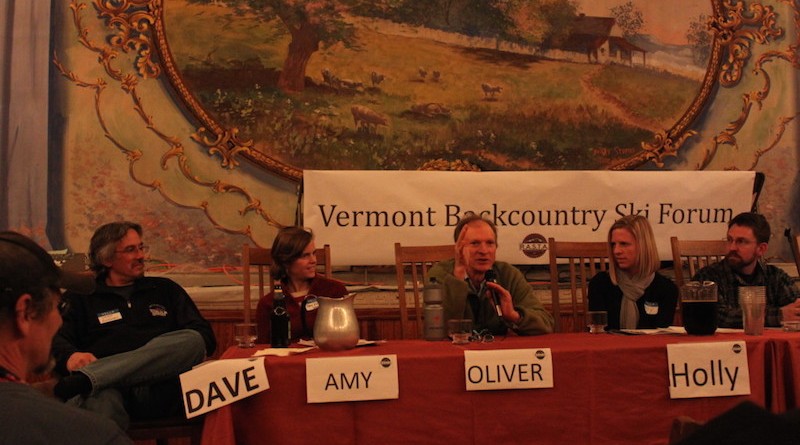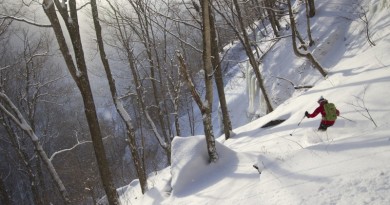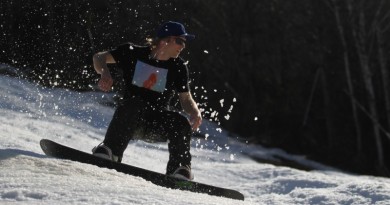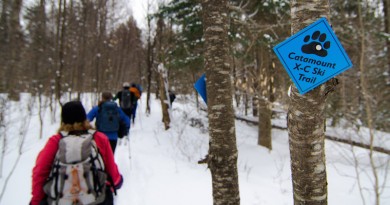Backcountry skiers organize for access
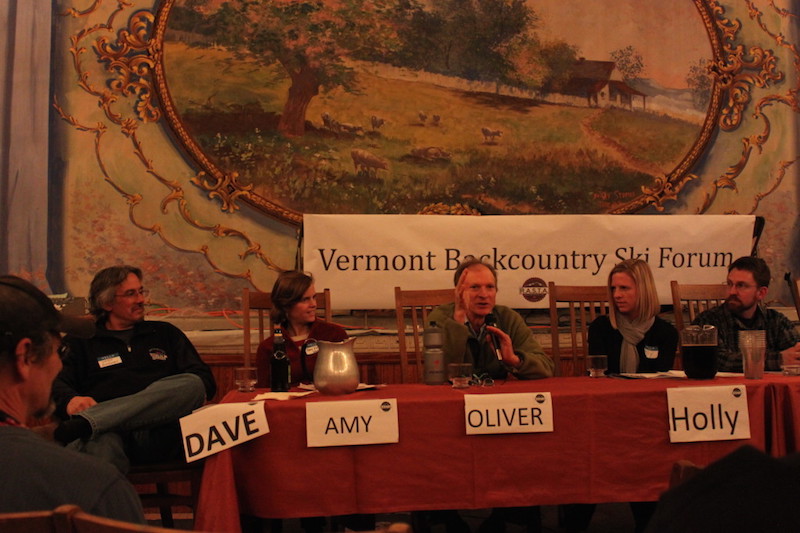
The leaders of the backcountry skiing movement hope to work with landowners in order to gain access to more trails.
by Evan Johnson
The thrill of the undiscovered is a constant allure for skiers in the Northeast and as long as there have been skis; people have cut their own tracks on the hillsides and through the woods in search of that perfect line or secret stash of pristine, untouched powder. This relentless pursuit is a mantra Rochester resident Dean Mendell wears on the back of his green baseball cap: “Ski Everywhere.”
Skiing everywhere, however, has become a hot button issue for both skiers and the owners or managers of the land on which they ski. It’s a discussion that produces more questions than answers, blurs the lines that separate public and private property and blends the interests of resorts like Killington, Jay, Stowe, Mad River Glen, or Sugarbush with that of guys like Mendell.
Mendell has lived in Rochester (population 1,139) for 40 years and says the valleys and hills along scenic Vermont Route 100 offer unparalleled potential for outdoor recreation. Last year, he and fellow skiers Dan McKinley and Greg White started kicking around the idea of a local organization that would promote backcountry skiing access on both public and private lands. The response was positive and, before long, the founders realized public interest included other forms of non-motorized year-round outdoor activities as well, not only backcountry skiing.
The result was the Rochester Area Sports Trail Alliance, or RASTA, a nonprofit organization now fully diving into the discussion of backcountry trail use and access.
“There are pockets of backcountry skiers that all go to where their little stashes are,” Mendell says. “What I’m trying to do is open it up and say we’re all in this together, let’s have some fun.”
A HISTORIC ACTIVITY
Dick Hall, founder of the North American Telemark Organization, says backcountry skiing is a historic activity, harkening back to the days when farmers, hunters, housewives, all used skis to get around and keep from sinking into the snow. For him, the good life is looking outside his kitchen window at six in the morning, seeing his skis with the bindings up, and venturing off somewhere to find adventure.
“I’ve never met anyone that used to backcountry ski,” he says. “I know lots of people who used to Alpine ski, I know lots of people who used to Nordic ski. Where do they wind up? Back in the wild.”
Hall says one of the best things about skiing in Vermont is how accessible it is. The Vermont Association of Snow Travelers trail system is more than 1,800 miles of maintained trails connecting towns from Bennington to Newport, snaking its way through most of the state. The Catamount Trail system runs the length of Vermont and has ample resources and clinics available for people looking to explore. Skiers can use these trails and others to access their own “secret stashes” or simply get around on the trails.
While Vermont was the first, and continues to be the only state in the country that leases public land to private ski resorts, the land leased to those seven resorts—Killington, Okemo, Jay Peak, Burke, Bromley, Stowe, and Smugglers’ Notch—totals less than 2 percent of the total acreage available to the general public. That leaves plenty of space for backcountry skiers to explore.
But to keep the best caches secret or share them with friends is a debate that divides most backcountry skiers into two camps.
Backcountry skiers can be famously defensive of their favorite lines, and as the discussion moves toward more public awareness of backcounty places to ski, many are reluctant to share.
David Goodman, a writer from Waterbury Center and the author of several guidebooks on backcountry skiing in New England, says he understands the desire for locals to maintain their own caches. But he also says skiers don’t have to give away all of their secrets by sharing what they love with newcomers.
“Skiers are incredibly and fiercely and wonderfully provincial. They know their backyard like nobody else,” he says. “But a lot of times people aren’t going to other places because they don’t know where to go. I don’t think you have to give away all your secrets to share what’s special about your area, if you just give people a taste of what’s great.”
ECONOMICS OF THE ISSUE
Larry Plesent, president of the Green Mountain Valley Business Community and founder and owner of Vermont Soap in Middlebury, describes local business owners in Rochester and the rest of the valley as “out to make a living, not a killing.”
“In the wake of Irene, there was this resounding echo of nothingness,” he says. “And we all got together and we said we have to work together and not only do we have to bring more business to the valley, but it has to be the right kind of business.”
The economics of backcountry skiing―calculating how much money it brings into the state―can’t be pinned down with much accuracy. While snowmobilers buy gasoline and skiers and snowboarders at any of the resorts buy lift tickets and stay in condominiums or hotels, it’s not the same with hikers, backcountry skiers and other wilderness travelers. That latter group yields imprecise and seldom revealing statistics for the Vermont Department of Tourism and Marketing as a wage to gauge their economic impact or value.
But Dean Mendell says backcountry skiing could be an opportunity to drive economic growth to Rochester and the White River Valley—an area that continues to recover what Tropical Storm Irene took away two years ago.
“What we have here in Rochester is a beautiful thing and nobody knows about it,” he says. “We have more Forest Service land than any other town―and they don’t pay taxes either, so where’s our revenue? This is the start of a revenue-based concept, bringing people here to backcountry ski.”
Megan Smith, commissioner of the Vermont Department of Tourism and Marketing, says backcountry skiing could be an asset to the area while at the same time allowing towns like Rochester to maintain much of their original character.
Locals, second home owners, and retailers, she says, would take on much of the responsibility for equipping newcomers as well as indoctrinating them in the sport.
“When you don’t have a hotel and you don’t have beds for people, you really have to rely on locals and second home owners,” she said at the Rochester meeting.
Forest Service: To cut or not to cut?
According to a 20-page document published by Vermont Department of Forests, Parks and Recreation, backcountry skiing is classified as an “allowable use” in the national forest, meaning it is not confined specifically to trails. Holly Knox, recreation and trails coordinator for the Green Mountain National Forest, says that while backcountry skiers can use any of the networks of trails on public property, there are few policies dictating how land should be managed for backcountry skiing.
“It’s something that we are trying to figure out and it’s raising a lot of management questions that we are trying to answer,” she told the Rochester gathering. “We’re contemplating should our designation be as trails or something that we can show on a map. We’re trying to meet what our users want and also meet our standards.”
But managing forests for skiing is difficult, especially when some have taken it upon themselves to “manipulate vegetation” (cutting trees) to maintain clear trails. Fragile environments like high elevation areas or areas trying to rebound from disturbances are particularly vulnerable. While skiers are permitted to use public lands, the priority for land management agencies is balancing skiers’ desire to enjoy the wilderness with the stability of the ecosystem.
Failure to maintain this balance can have disastrous effects. The most alarming example in recent memory was in 2009 when two skiers used chainsaws to cut nearly 1,000 trees and create a 40-foot-wide by 2,000 feet long swath on Big Jay Mountain. The two men later pleaded no contest to federal charges of unlawful mischief, but the incident, many agree, was a black eye for the entire community.
Since then, local skiers and appropriate officials are quick to temper any enthusiasm about attracting a larger number of backcountry skiers to the state with caution.
Oliver Blackman, a ski instructor and ski patroller at Smuggers’ Notch, has also witnessed firsthand the results of various forest maintenance practices and watched the evolution of the “glade” trail.
Blackman says all the glades he remembers are now open trails, due to the manner in which the lines are maintained. Many ski areas feature areas glades that have significantly altered the composition of the landscape. Areas where saplings and deadfall have been cleared away have eliminated the understory of the forests, he says, threatening their stability and ability to regenerate.
“If you’re looking to make a glade sustainable, the only way to do it sensibly is to define spaces instead of individual stems. That way, there’s diversity in age classes, [and] diversity in species,” he says.
The solution, he maintains, is a compromise.
“I like to think that there should be something for everybody in the spectrum,” he says. “Some people love to ski tight little wormholes. Some people like to ski wide-open spaces. The fact that as much trimming goes on right now indicates that there is a demand for something somewhere in between what a commercial ski area offers and what any of us can achieve by being industrious.”
NATO’s Hall says the procedure is unnecessary. For him, it’s all about knowing where to go.
“Thirty percent of where we live is forest wilderness,” he says. “Go somewhere where you don’t hit brush. I could show you glades [where] you could get 200 turns with trees eight feet apart in pristine powder today.”
IMAGE CONTROL
After the disastrous cut at Big Jay and a rash of lost skiers, notably at Killington Resort in the past year or two, the backcountry community finds itself lumped together with chainsaw-wielding outlaws or down-country wannabes ducking ropes to ski out of bounds.
It’s an image problem that some attribute to steroid-injected ski publications or films that raise lofty expectations of what a ski experience should be, while others point the finger at resorts that offer an exclusively “backcountry” experience.
From the resort’s perspective, it’s a mishmash of experiences that yield a unique policy at each resort. With the seven resorts that have leased land on state forests, areas like Stowe have been somewhat lenient in the past, allowing limited access during limited times to the top of Mount Mansfield and surrounding areas. Other resorts, like Mad River Glen, which is built in its entirety on private land, has seen a change in attitude over the years because of past abuse. MRG’s Vice President of Communication Eric Friedman recently said the resort used to be more lenient—selling single ride lifts for a nominal fee, for example—but had to stop because too many skiers were taking multiple rides on their single ride ticket. “It was just too difficult to enforce; it wasn’t worth the aggravation.”
And, Friedman says, “those are our people,” a nod to the backcountry skier mindset that thrives on less material things, not more. “The problem,” Friedman says, “is that we have to be in the business of making enough money to pay the bills, and if you have a group of free-loaders getting first tracks down our runs, and skiing for free down our steeps, it takes away from our loyal customers.”
Friedman says Mad River Glen, and other resorts, are happy to allow backcountry skiers access to their terrain pre-season and post-season. Some resorts also allow skiers access after the lifts have shut down for the day, but there needs to be a general understanding of what the guidelines are per each resort before backcountry skiers “poach” groomed terrain.
That said, the resort community in Vermont as a group does not have a formal policy on backcountry skiing, according to Vermont Ski Area Association President Parker Rhiele, who would say only that the association and ski resorts would likely keep an “open mind” on the issue and try to address upcoming discussions with “flexibility.”
Few Vermont resorts have a stated policy on backcountry skiing. While Jay has an open policy, Mad River and Sugarbush are relatively closed. Michael van Eyck, director of marketing at Bromley, said the resort’s location on national forest land means it has to adopt the same policy as the regulatory agency. Bonnie MacPherson, public relations director at Okemo, said the resort “strongly discourages” customers from skiing out of bounds. Bolton Valley has backcountry skiing as part of a designated Nordic and backcountry terrain. The area is accessible by chairlift and maps are available with valid trail ticket or season pass. People are discouraged from accessing other backcountry areas that are not in this area. Skiers at Smugglers’ Notch can access the backcountry from their area as long as they have a valid pass or ticket. Once they are beyond the boundary, the resort is no longer bound to provide any rescue services and any services provided may be billed.
What all agree on, however, is that the actions of a few have affected the entire community. Last year, a bill presented to the Vermont Legislature by Killington-area representatives last year would have charged skiers for the cost of their own search and rescue missions.
It failed for several reasons, with the state police and backcountry rescuers both opposed to the law, including the likelihood the victims and their families would be hesitant to call for help sooner and might, therefore, put more people—and rescuers—in danger. Goodman says the law was also misguided.
“When they proposed the law, I don’t think they were even thinking about backcountry skiers,” he says. “They were thinking about kids from New Jersey ducking out-of-bounds and getting lost. The only thing is, in that big net that they threw out, the real thing they pulled in when the net came up was us.”
POLICING THEIR OWN?
Even though the bill failed, many view it as a warning. With that in mind, RASTA has begun to discuss ways of cleaning up the image of off-piste enthusiasts and policing themselves.
“We’ve lost the public relations battle,” Blackman says. “Other users of backcountry land are assumed to be virtuous―hikers are wonderful stewards of the environment, [while] skiers are dirtbag criminals. We need somebody to change that.”
Amy Kelsey, Executive Director of the Catamount Trail Association, points to the lists of standards ranging from the Snowsports Industry of America’s Backcountry Code to the Vermont Trail Ethic from the Vermont Trails and Greenways Council. The Catamount Trail Association encourages users to practice Leave-No-Trace and to respect private landowners.
“I think a lot of the basic elements are already there,” she says. “We just need to find a way to share them in a unified way with a broad audience.”
Some are advocating for a backcountry skiers advocacy group that would act as a unified representative body. Jason Duquette-Hoffman, co-founder and owner of Vermont-based ski company Worth Skis, says a dialogue between policymakers and the trail users is necessary.
“What I hear from people that have access to policy development is that they don’t understand what we need and they don’t understand how to translate it into policies that make sense on a statewide basis. What we really need to do is help them. This (meeting) gives them a sense of who we are, but we really need to step up and give them that advisory capacity.”
Mendell says the solution is a little more basic.
“Everyone needs to step up and communicate what we all do,” he says. “We love what we do and that communication is key. Do we want to keep it in our back pocket or do we want to share it with someone? It’s not a secret, it’s all about the fun.”

